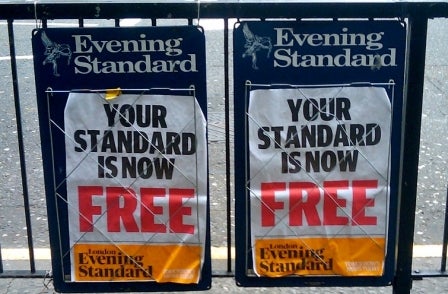
The Evening Standard appears to have completed the greatest comeback since Lazarus.
Six years ago it was dying what can only be described as a horrible and painful death in the face of competition from News International’s free daily thelondonpaper and its own free title London Lite.
It was losing paid-for sales at between 10 and 20 per cent per year and more than £10m in financial terms.
Today that loss has been turned into a modest profit of around £1m a year. With a fair wind and some sort of economic upturn they could even start making serious money in the years to come.
What does this all mean for the future of journalism? Print is clearly far from dead. But paid-for daily newspapers obviously have some big issues.
Back in the days of the free London newspaper war, the two free titles struggled to shift more than 500,000 copies a day without resorting to dumping them in skips – and they employed an army of merchandisers to shove them into the hands of commuters.
Today the Evening Standard has a daily circulation of 700,000 largely through drop-off boxes where readers pick the paper up themselves. This is no small achievement and proves that investment in editorial makes a difference – even for a free title.
The Standard has lost journalists over the last three years – mainly as result of dropping the second edition and merging sport and business desks with The Independent.
But with the likes of Brian Sewell, Simon Jenkins and Matthew D’Ancona on the columnists roster and heavyweight specialist reporting teams it remains a free newspaper resourced like no other in the world.
FORMER FHM editor Ross Brown emerged this week as an unlikely supporter of the Take the Bare Boobs Out of The Sun campaign.
He told an audience of students at City University: “One of my best friends is the editor of Nuts and we spend much of our time arguing. I think it’s just reached a point where it’s readily accessible porn, from Page Three to Nuts. And we’re past that.”
For what it’s worth I agree with him. The Sun is a brilliantly produced paper and my only major criticism is that I never know what it is reported on pages two and three because I have to skim through them on the train rather than give the impression that I am openly ogling at naked breasts in front of my fellow commuters.
The campaign has been misreported as calling for a ban on Page Three. It isn’t, it is a petition addressed at Sun editor Dominic Mohan trying to change his mind about the policy of showing topless models on Page Three.
I defend the The Sun’s right to publish what it wants within reason. But as a reader, I would rather it didn’t objectify women in the way it does.
It particularly grates when you are reading a frontpage story about Jimmy Savile’s nefarious sexual exploits and then turn to page three to see a picture of a semi-naked young woman.
Email pged@pressgazette.co.uk to point out mistakes, provide story tips or send in a letter for publication on our "Letters Page" blog
